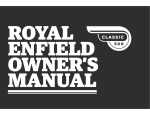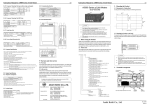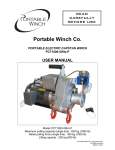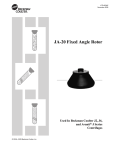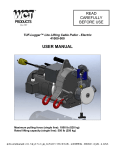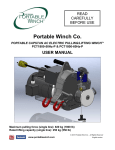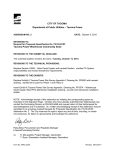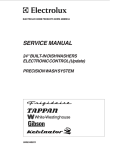Download Stage 2
Transcript
TABLE OF CONTENTS FEATURES ........................................................................................ PRECAUTIONS ................................................................................. LOCATION OF THE CONTROLS ...................................................... INSTALLATION .................................................................................. OPERATION DIAGRAM .................................................................... USING THE CONTROLLER .............................................................. Parameter Ranges ......................................................................... Factory Settings ............................................................................. The Meaning of a Flashing Display ................................................ Temperature Units ......................................................................... Room Temperature ........................................................................ RoomTemperature Display ........................................................ Probe Temperature Display ....................................................... Minimum / Maximum Temperature Recall ................................. Minimum / Maximum Temperature Reset .................................. Temperature Set Point / Temperature Curve ............................. Stage 1 - Curtains .......................................................................... Stage 2 - Cooling / Heating / Misting .............................................. Alarms ............................................................................................ Manual Operation .......................................................................... Locking the Parameters ................................................................. TROUBLESHOOTING GUIDE ........................................................... TECHNICAL SPECIFICATIONS ........................................................ 3 5 6 9 13 14 14 15 16 16 17 17 17 18 19 20 24 30 39 40 41 42 45 FOR CUSTOMER USE Enter below the serial number located on the side of the controller and retain this information for future reference. CWS-T-11HA Model number Serial number 2 CWS-T-11HA.rev.03 FEATURES The CWS-T-11HA is an electronic device used for environmental control in livestock buildings. It allows the user to maintain a specified target temperature by controlling the operation of ventilation and heating equipment. One stage of either constant speed fans, heating units or mist sprinklers, as well as curtains for natural ventilation can be connected to the controller. The main features of the controller are as follows: DIGITAL DISPLAY A digital display shows temperatures and other operation parameters. PILOT LIGHTS Pilot lights indicating the status of outputs allow you to monitor the operation of the system at a distance. TEMPERATURE CURVE A temperature curve comprised of six different points provides an automatic adjustment of the target room temperature over a given period of time. FOUR INDEPENDENT TEMPERATURE PROBE INPUTS Up to four temperature probes can be connected to the controller in order to obtain a more accurate reading of the average room temperature and a faster reaction time. HIGH/LOW TEMPERATURE AND POWER FAILURE ALARMS The controller generates an output signal that will activate any alarm system in case of a rise or fall in temperature beyond a specified limit, a power failure or a fault in the supply circuit. CWS-T-11HA.rev.03 3 ROOM TEMPERATURE COMPENSATION ON NATURAL VENTILATION OUTPUT (OPTIONAL) The controller compensates the curtain timer settings proportionally to the room temperature. The lower the room temperature, the faster the curtains close. The higher the room temperature, the faster the curtains open. OVERLOAD AND OVERVOLTAGE PROTECTION Fuses are located at the input and outputs of the controller to protect its circuitry in the case of an overload or overvoltage. COMPUTER CONTROL The controller can be connected to a computer, thus making possible the centralization of information management and a more diversified control strategy. ADAPTS TO ALL TYPES OF AIR INLET POWER UNITS 4 CWS-T-11HA.rev.03 PRECAUTIONS We strongly recommend installing a back-up thermostat on stage 2 (refer to the wiring diagram enclosed with this user's manual to connect the thermostat) as well as an independent failure alarm system and a curtain drop or manual winch . Fuses at the input and outputs of the controller adequately protect its circuitry in the case of an overload or overvoltage. However, we recommend installing an additional protection device on the supply circuit as well as an external relay on stage 2 to prolong the life of the controller. To avoid exposing the controller to harmful gases or excessive humidity, it is preferable to install it in a corridor. The room temperature where the controller is located MUST ALWAYS REMAIN BETWEEN 0° AND 40°C (32° AND 104°F). DO NOT SPRAY WATER ON THE CONTROLLER CWS-T-11HA.rev.03 5 LOCATION OF THE CONTROLS 6 CWS-T-11HA.rev.03 1 Digital display Displays temperatures and other parameters shown around the parameter selection knob. 2 Opening pilot light Turns on when the curtains are opening. 3 Closing pilot light Turns on when the curtains are closing. 4 Stage 2 pilot light Turns on when the stage 2 fans, heating units or misting units are on. 5 Temperature curve pilot light Turn on when the temperature curve is activated. 6 Defective probe pilot light Turn on when a probe is defective. 7 Alarm pilot light Turns on when the alarm is activated. 8 Locked parameter pilot light Turns on when the parameters are locked. 9 Parameter selection knob Used to select a parameter. 10 Push-button Used to access the various adjustments. 11 Adjustment knob Used to adjust the value of a selected parameter. CWS-T-11HA.rev.03 7 13 Internal switches Used to set the operationg modes as described in the table below. SWITCH DESCRIPTION 8 # POSITION OPERATING MODE Parameters 1 ON OFF Locked parameters Unlocked parameters Temperature units 2 ON OFF ° Celsius ° Fahrenheit Probe # 2 3 ON OFF Probe # 2 activated Probe # 2 deactivated Probe # 3 4 ON OFF Probe # 3 activated Probe # 3 deactivated Probe # 4 5 ON OFF Probe # 4 activated Probe # 4 deactivated Heat/cool/mist option 6/8 Curtain Compensation 7 CWS-T-11HA.rev.03 Stage 2 used for heating 6: ON 6: OFF | 8: OFF Stage 2 used for cooling 6: OFF | 8: ON Stage 2 used for misting ON OFF Progressive mode Normal mode INSTALLATION Mounting Instructions Remove the four screws in the front cover and lift the cover. Remove the black caps located on the three mounting holes. Mount the enclosure to the wall using three screws. Be sure the electrical knockouts are at the bottom of the enclosure in order to prevent water from entering the controller. Insert the screws into the mounting holes and tighten. Fasten the black caps onto the mounting holes. Connections To connect the controller, refer to the wiring diagram enclosed with this user's manual. Set the voltage switch to the appropriate line voltage. Voltage switch Route the cables through the electrical knockouts provided at the bottom of the enclosure. Do not make additional holes in the enclosure, particularly on the side of the enclosure when using a computer communication module. Inside of the enclosure CWS-T-11HA.rev.03 9 If stage 2 is used for heating, it may be necessary to install a transformer in order to supply the correct voltage to the heating units. CONCERNING THE ALARM CONNECTION: There are two types of alarms in the industry. One type activates when current is cut off at its input, whereas the other activates when current is supplied at its input. For an alarm of the first type, use the NO terminal as shown in the wiring diagram. For an alarm of the second type, use the NC terminal. ALL WIRING MUST BE DONE BY AN AUTHORIZED ELECTRICIAN AND MUST COMPLY WITH APPLICABLE CODES, LAWS AND REGULATIONS. BE SURE POWER IS OFF BEFORE DOING ANY WIRING TO AVOID ELECTRICAL SHOCK AND EQUIPMENT DAMAGE. Temperature Probes The controller is supplied with one temperature probe connected to terminal # 1. CAUTION : The probes operate under low voltage and are isolated from the supply. Be sure the probe cables remain isolated from all high voltage sources. Do not route the probe cables and other power cables through the same electrical knockout. Do not run the probe cables next to other power cables. When crossing over other cables, cross at 90o. Extending the probes Each probe can be extended up to 500 feet (150 meters). To extend a probe: Use a shielded cable of outside diameter between 0.245 and 0.260 in (6.22 and 6.60 mm) to ensure the cable entry is liquidtight (the cable dimension should not be under 18 AWG). 10 CWS-T-11HA.rev.03 It is preferable to weld the cable joint to ensure a proper contact between the two cables. Do not ground the shielding. Connecting Additional Probes Three additional probes may be connected to the controller in order to obtain a more accurate reading of the average room temperature and a faster reaction time. Connect each additional probe using terminals # 2, # 3 and # 4, as shown on the wiring diagram enclosed with this user’s manual. Switches are used to activate or deactivate the additional probes connected to the controller. Activate each additional probe by setting the appropriate switch to ON: Switch # 3 activates the probe connected to terminal # 2. Switch # 4 activates the probe connected to terminal # 3. Switch # 5 activates the probe connected to terminal # 4. FACTORY SETTING: When the controller is shipped from the factory, switches # 3, # 4 and # 5 are set to OFF (probes are deactivated). CWS-T-11HA.rev.03 11 Defective Probes If one or many probes are defective, the defective probe pilot light turns on. The average temperature measured by the probes remaining in proper condition is displayed when the parameter selection knob is set to ROOM TEMPERATURE and the controller operates according to this temperature. If all the probes are defective, the display shows the letter "P" when the parameter selection knob is set to ROOM TEMPERATURE, the controller stops operating the stages and activates the alarm. To identify the defective probe: Set the selection knob to ROOM TEMPERATURE. The room temperature is displayed. Press the push-button. If the probe connected to terminal # 1 and supplied with the controller is not defective, "PR1" is displayed, alternating with the temperature measured by the probe. Otherwise, "PR1" is displayed, alternating with "P". For each additional probe connected to the controller: Press the push-button once again. If the probe is not defective, "PR#" is displayed (where # is the number of the terminal the probe is connected to), alternating with the temperature measured by the probe. Otherwise, "PR#" alternates with "P". 12 CWS-T-11HA.rev.03 Heat / Cool / Mist Options Stage 2 can be used either for cooling, heating or mist cooling. Set switch # 6 to the required position: 6: ON for stage 2 to operate as a heating stage. 6: OFF / 8: OFF for stage 2 to operate as a cooling stage. 6: OFF / 8: ON for stage 2 to operate as a mist cooling stage. FACTORY SETTING: When the controller is shipped from the factory, switches # 6 and #8 are set to ON (stage 2 operates as a heating stage). CWS-T-11HA.rev.03 13 USING THE CONTROLLER Parameter Ranges PARAMETER TEMPERATURE SET POINT STAGE 1 CURTAINS STAGE 2 COOLING OR HEATING ADJUSTMENT RANGE -40.0° to 99.9°F (-40° to 37.7°C) Differential 0.5° to 20.0°F (0.3° to 11.1°C) Time opening 1 to 900 seconds Time closing 1 to 900 seconds Time off 0 to 900 seconds Differential 0.5° to 20.0°F (0.3° to 11.1°C) Heating Offset - activated - deactivated -9.9° to 20.0°F (-5.5° to 11.1°C) 0.0° to 20.0°F (0.0° to 11.1°C) Time on 0 to 900 seconds, by increments of 15 seconds Time off 0 to 900 seconds, by increments of 15 seconds High offset 0.5° to 40.0°F (0.3° to 22.2°C) Low offset 0.5° to 40.0°F (0.3° to 22.2°C) ALARM 14 CWS-T-11HA.rev.03 Factory Settings The controller is programmed at the factory with the settings shown below. Keep the settings that are convenient for you and make changes where necessary. NOTES: (1) The controller only memorizes the last parameter settings. Each new setting replaces the preceding one. (2) If the power supply is cut off, the last parameter setting will be kept in memory until the power is restored. PARAMETER FACTORY SETTING Set point 75.0°F (23.9°C) Temperature curve OFF Differential 3.0°F (1.7°C) STAGE 1 - Time opening 20 seconds CURTAINS Time closing 20 seconds Time off 60 seconds Differential 2.0°F (1.1°C) Offset 0.5°F (0.3°C) Time on 15 seconds Time off 30 seconds High offset 12.0°F (6.7°C) Low offset 10.0°F (5.6°C) TEMPERATURE SET POINT STAGE 2 COOLING OR HEATING ALARM CWS-T-11HA.rev.03 15 The Meaning of a Flashing Display The display flashes certain values and does not flash others. The flashing indicates that the displayed value can be adjusted. A value that is not flashing can not be adjusted. Temperature Units Temperatures can be displayed either in degrees Celsius or in degrees Fahrenheit. Set switch # 2 to the desired position: ON to display temperatures in degrees Celsius. OFF to display temperatures in degrees Fahrenheit. FACTORY SETTING: When the controller is shipped from the factory, switch # 2 is set to OFF (temperatures are displayed in degrees Fahrenheit). 16 CWS-T-11HA.rev.03 Room Temperature Room Temperature Display The room temperature is the average value of all temperatures measured by probes that are activated and in proper operating condition. DISPLAYING THE ROOM TEMPERATURE Set the parameter selection knob to ROOM TEMPERATURE. The room temperature appears on the display. Probe Temperature Display DISPLAYING PROBE TEMPERATURES Set the parameter selection knob to ROOM TEMPERATURE. The ambient temperature appears on the display. Press the push-button. "PR1" is displayed, alternating with the temperature measured by the probe connected to terminal # 1 (supplied with the controller). CWS-T-11HA.rev.03 17 DISPLAYING PROBE TEMPERATURES (CONT'D) For each additional probe connected to the controller: Press the push-button again. "PR#" (where # is the terminal number to which the probe is connected) is displayed, alternating with the temperature measured by the probe. Minimum / Maximum Temperature Recall The minimum and maximum temperatures are the lowest and highest values of all room temperatures measured since the last reset. RECALLING MINIMUM AND MAXIMUM TEMPERATURES Set the parameter selection knob to ROOM TEMPERATURE. The room temperature appears on the display. Turn the adjustment knob clockwise by one notch. The minimum temperature appears flashing on the display. Turn the adjustment knob clockwise one notch further. The maximum temperature appears flashing on the display. Turn the adjustment knob clockwise a third notch. The room temperature again appears on the display. If the adjustment knob is turned counterclockwise rather than clockwise, the display sequence will be reversed (room-maximumminimum-room). 18 CWS-T-11HA.rev.03 Minimum / Maximum Temperature Reset The reset erases the current minimum and maximum temperatures. From the moment the reset is completed, the controller begins to store in memory the new minimum and maximum temperatures measured by the probes. RESETTING MINIMUM AND MAXIMUM TEMPERATURES Set the parameter selection knob to ROOM TEMPERATURE. The room temperature appears on the display. Turn the adjustment knob clockwise (or counterclockwise) by one notch and leave it in this position. The minimum (or maximum) temperature first appears flashing on the display. After 10 seconds, the display stops flashing and the room temperature again appears on the display, indicating that the reset is completed. NOTE : To avoid resetting the minimum et maximum temperatures while recalling them, be sure to return to the room temperature display within the 10 second delay. CWS-T-11HA.rev.03 19 Temperature Set Point / Temperature Curve There are two ways to specify the target room temperature: 1 Adjust the temperature set point to the desired value and do not activate the temperature curve. The controller will operate according to this target room temperature as long as the temperature curve remains deactivated. 2 Program a temperature curve comprised of six points and activate the temperature curve. For each of the six points, you must specify a day number and a temperature set point for this day number. The controller will automatically change the target room temperature every hour in a linear fashion between two consecutive points. When the last point is reached, the temperature curve becomes deactivated. The controller continues to operate according to the last temperature set point until you activate the temperature curve once again or specify a new temperature set point. You can also deactivate the temperature curve before the last point is reached. The temperature set point and the points of the temperature curve can be adjusted only if the temperature curve is deactivated: If the temperature curve pilot light is off, the temperature curve is presently deactivated and you can proceed with the adjustment. If the temperature curve pilot light is on, the temperature curve is presently activated. Before proceeding with the adjustment, deactivate the curve as follows. To deactivate the temperature curve Set the parameter selection knob to SET POINT/ TEMP.CURVE. The current temperature set point appears flashing on the display. Press the push-button repeatedly until the word ON appears flashing on the display. Turn the adjustment knob counterclockwise one notch and leave it in this position for at least 10 seconds. The word OFF appears flashing on the display and after 10 seconds, the temperature curve pilot light turns off, indicating that the temperature curve is now deactivated. Set the parameter selection knob to ROOM TEMPERATURE. 20 CWS-T-11HA.rev.03 ADJUSTING THE TEMPERATURE SET POINT Be sure the temperature curve is deactivated (see above). Set the parameter selection knob to SET POINT/ TEMP.CURVE. The current temperature set point appears flashing on the display. Using the adjustment knob, adjust the set point to the desired value. PROGRAMMING THE TEMPERATURE CURVE NOTES: All six points of the curve must be specified. If you do not need six different points, repeat your last temperature set point for each unnecessary point of the curve. To reduce the risk of errors: - The highest possible day number is 99. You can not specify decreasing day numbers. You can not specify an increasing temperature curve. The temperature variation can not exceed 3°F (1.6°C) per day. To specify the six points of the temperature curve: Be sure the temperature curve is deactivated (see above). Set the parameter selection knob to SET POINT/TEMP.CURVE. The current temperature set point appears flashing on the display. Press the push-button. The word OFF appears on the display, indicating that the temperature curve is deactivated. CWS-T-11HA.rev.03 21 PROGRAMMING THE TEMPERATURE CURVE (CONT'D) Repeat the following steps for each of the six points: Press the push-button once again. A day number, preceded by the letter "d", appears flashing on the display. Using the adjustment knob, adjust the day number to the desired value. Press the push-button once again. The current temperature set point for this day number appears flashing on the display. Using the adjustment knob, adjust the temperature set point to the desired value. When the six points of the temperature curve have been specified, activate the curve as follows. To activate the temperature curve Press the push-button once again. The word OFF appears flashing on the display. Turn the adjustment knob clockwise one notch and leave it in this position for at least 10 seconds. The word ON appears flashing on the display and after 10 seconds, the temperature curve pilot light turns on, indicating that the temperature curve is now activated. Set the parameter selection knob to ROOM TEMPERATURE. 22 CWS-T-11HA.rev.03 PROGRAMMING THE TEMPERATURE CURVE (CONT'D) NOTE: When the temperature curve is activated, the current target room temperature and the current day number can be viewed at any time. The current day number can also be adjusted to move forward or backward on the temperature curve. To display the temperature set point and to display and adjust the current day number: Set the parameter selection knob to SET POINT / TEMP.CURVE. The current temperature set point appears flashing on the display. Press the push-button. The current day number is displayed. Use the adjustment knob to set the day number to the desired value. CWS-T-11HA.rev.03 23 Stage 1 - Curtains Description of Operation ( Refer to figure 1 on next page) When the room temperature rises to "temperature set point + differential" (point 1), the curtains begin to open and continue to do so as long as the room temperature remains above this point. The curtains open intermittently according to the time opening and time off settings: During TIME OPENING, the curtains open. During TIME OFF, the curtains stop opening. When the room temperature falls to "temperature set point - differential" (point 2), the curtains begin to close and continue to do so as long as the room temperature remains below this point. The curtains close intermittently according to the time closing and time off settings: During TIME CLOSING, the curtains close. During TIME OFF, the curtains stop closing. 24 CWS-T-11HA.rev.03 CWS-T-11HA.rev.03 25 Curtain Operating Time Compensation as a Function of Room Temperature 1 When switch # 7 is set to OFF (normal mode): The curtains open and close intermittently according to the specified time opening, time closing and time off, as described on the previous page. There is no room temperature compensation. 2 When switch # 7 is set to ON (progressive mode): The controller compensates the time opening, time closing and time off according to the room temperature, as described hereafter: When the curtains open: Each time the room temperature rises by a certain number of degrees above "temperature set point + differential" , the controller multiplies the time opening by a given factor and reduces the time off so that the total cycle time remains constant. The higher the room temperature, the faster the curtains open. When the time off is below 10 seconds, the curtains begin to open continuously. When the curtains close: Each time the room temperature falls by a certain number of degrees below "temperature set point - differential" , the controller multiplies the time closing by a given factor and reduces the time off so that the total cycle time remains constant. The lower the room temperature, the faster the curtains close. When the time off is below 10 seconds, the curtains begin to close continuously. 26 CWS-T-11HA.rev.03 Table 1 below shows multiplication factors used when the room temperature rises above the set point plus the differential (curtains open) or falls below the set point minus the differential (curtains close). EXAMPLE. Suppose that you have specified the following values: When the room temperature rises to "temperature set point + differential + 1°F (0.6°C)": When the room temperature rises to "temperature set point + differential + 2°F (1.2°C)": When the room temperature rises to "temperature set point + differential + 3°F (1.8°C)": CWS-T-11HA.rev.03 27 When the room temperature rises to "temperature set point + differential + 4°F (2.2°C)", the time off is below 10 seconds. The curtains therefore begin to open continuously: ADJUSTING THE CURTAIN PARAMETERS ADJUSTING THE CURTAIN DIFFERENTIAL Set the parameter selection knob to CURTAINS -DIFFERENTIAL. The current curtain differential appears flashing on the display. Using the adjustment knob, adjust the differential to the desired value. ADJUSTING THE CURTAIN TIME OPENING Set the parameter selection knob to CURTAINS - TIME OPENING. The current curtain time opening appears flashing on the display. Using the adjustment knob, adjust the time opening to the desired value. 28 CWS-T-11HA.rev.03 ADJUSTING THE CURTAIN TIME CLOSING Set the parameter selection knob to CURTAINS - TIME CLOSING. The current curtain time closing appears flashing on the display. Using the adjustment knob, adjust the time closing to the desired value. ADJUSTING THE CURTAIN TIME OFF Set the parameter selection knob to CURTAIN - TIME OFF. The current curtain time off appears flashing on the display. Using the adjustment knob, adjust the time off to the desired value. CWS-T-11HA.rev.03 29 Stage 2 - Cooling / Heating / Mist Cooling COOLING MODE Description of Operation ( Refer to figure 2 on next page) If the room temperature rises (Figure 2.a): • When the room temperature rises to "temperature set point + offset + differential" (point 3), the fans begin to run according to the cooling timer settings. • When the room temperature rises to " temperature set point + offset + differential " (point 3), the fans operate nonstop. If the room temperature falls (Figure 2.b): • When the room temperature is greater than "temperature set point + offset" (point 4), the fans operate nonstop. • When the room temperature falls to " temperature set point + offset " (point 4), the fans begin to run according to the cooling timer settings. 30 CWS-T-11HA.rev.03 CWS-T-11HA.rev.03 31 Cooling Timer Operation: Cooling timer: During TIME ON, the fans are on. During TIME OFF, the fans are off. To run the fans intermittently: set TIME ON to the desired on time and TIME OFF to the desired off time. To run the fans continuously: set TIME OFF to zero and TIME ON to any value other than zero. To stop the fans: set TIME ON to zero and TIME OFF to any value (equal to or other than zero). ADJUSTING THE COOLING PARAMETERS ADJUSTING THE COOLING DIFFERENTIAL Set the parameter selection knob to STAGE 2 - DIFFERENTIAL. The current cooling differential appears flashing on the display. Using the adjustment knob, adjust the differential to the desired value. ADJUSTING THE COOLING OFFSET Set the parameter selection knob to STAGE 2 - OFFSET. The current cooling offset appears flashing on the display. Using the adjustment knob, adjust the offset to the desired value. 32 CWS-T-11HA.rev.03 ADJUSTING THE COOLING TIMER Set the parameter selection knob to STAGE 2 - TIMER. The word ON and the current cooling time on alternately appear flashing on the display. Using the adjustment knob, adjust the time on to the desired value. Press the push-button. The word OFF and the current cooling time off alternately appear flashing on the display. Using the adjustment knob, adjust the time off to the desired value. CAUTION : On and off times are in seconds. HEATING MODE Description of operation ( Refer to figure 3 on next page) If the room temperature rises (Figure 3.a): • When the room temperature is below "temperature set point - offset" (point 5), the heating units are on. • When the room temperature rises to "temperature set point - offset" (point 5), the heating units turn off. If the room temperature falls (Figure 3.b): • When the room temperature is greater than "temperature set point offset - differential" (point 6), the heating units are off. • When the room temperature falls to "temperature set point - offset differential" (point 6), the heating units turn on. NOTE: Heating units do not operate with the timer. CWS-T-11HA.rev.03 33 34 CWS-T-11HA.rev.03 ADJUSTING THE HEATING PARAMETERS ADJUSTING THE HEATING DIFFERENTIAL Set the parameter selection knob to STAGE 2 DIFFERENTIAL. The current heating differential appears flashing on the display. Using the adjustment knob, adjust the differential to the desired value. ADJUSTING THE HEATING OFFSET The heating offset is the number of degrees below the set point at which the heating units turn off. The heating offset can provide substantial energy savings if correctly adjusted according to the outside temperature. When the heating offset is disabled, it can only be set to a positive value. When enabled, it can be adjusted to a positive or negative value. A negative value lets the heating units operate at ambient temperatures greater than the set point. Enabling / Disabling the Heating Offset Set the selection knob to STAGE 2 - OFFSET. The current offset value flashes on the display. Press the push-button. The status of the offset is displayed, i.e. ON/OFF. Turn the adjustment knob one knotch to the right to enable the offset (the display flashes ON), or one knotch to the left to disable the offset (the display flashes OFF). CWS-T-11HA.rev.03 35 ADJUSTING THE HEATING OFFSET Set the parameter selection knob to STAGE 2 - OFFSET. The current heating offset appears flashing on the display. Using the adjustment knob, adjust the offset to the desired value. MIST COOLING MODE DESCRIPTION OF OPERATION ( Refer to figure 4 on next page) If the room temperature rises (Figure 4.a): • When the room temperature is less than "temperature set point + offset + differential" (point 7), the misting units are turned off. • When the room temperature rises to "temperature set point + offset + differential" (point 7), the misting units operate according to the mist timer. If the room temperature falls (Figure 4.b): • When the room temperature is greater than "temperature set point + offset" (point 8), the misting units operate according to the mist timer. • When the room temperature falls to "temperature set point + offset" (point 8), the misting units are turned off.. 36 CWS-T-11HA.rev.03 CWS-T-11HA.rev.03 37 ADJUSTING THE MIST PARAMETERS ADJUSTING THE MIST DIFFERENTIAL Set the parameter selection knob to STAGE 2 - DIFFERENTIAL. The current differential appears flashing on the display. Using the adjustment knob, adjust the differential to the desired value. ADJUSTING THE MIST OFFSET Set the parameter selection knob to STAGE 2 - OFFSET. The current offset appears flashing on the display. Using the adjustment knob, adjust the offset to the desired value. ADJUSTING THE MIST TIMER Set the parameter selection knob to STAGE 2 - TIMER. The word ON and the current time on alternately appear flashing on the display. Using the adjustment knob, adjust the time on to the desired value. Press the push-button. The word OFF and the current time off alternately appear flashing on the display. Using the adjustment knob, adjust the time off to the desired value. CAUTION : On and off times are in minutes.. 38 CWS-T-11HA.rev.03 Alarms High Temperature Alarm The controller activates the alarm when the room temperature rises to “temperature set point + high offset”. ADJUSTING THE HIGH OFFSET Set the parameter selection knob to ALARM OFFSET - HIGH. The current high offset appears flashing on the display. Using the adjustment knob, adjust the high offset to the desired value. Low Temperature Alarm The controller activates the alarm when the room temperature falls to “temperature set point - low offset”. ADJUSTING THE LOW OFFSET Set the parameter selection knob to ALARM OFFSET - LOW. The current low offset appears flashing on the display. Using the adjustment knob, adjust the low offset to the desired value. CWS-T-11HA.rev.03 39 POWER FAILURE, SUPPLY CIRCUIT FAULT OR FAILURE OF ALL PROBES The controller activates the alarm in the event of a power failure, a fault in the supply circuit or a failure in all probes. Manual Operation Manual operation allows you to interrupt the operation of the curtains. When the parameter selection knob is set to MANUAL OPERATION, the curtains do not operate. When the parameter selection knob is set to any position other than MANUAL OPERATION, the curtains operate according to the parameter settings. Manually Operating the Curtains Set the selection knob to the MANUAL position. The display flashes OFF and stops the curtains after five seconds. Press the push-button. The display flashes OPE and the curtains start opening after five seconds. Press the push-button once again. The display flashes CLO and the curtains start closing after five seconds. Keep pressing the push-button to stop, open and close the curtains in that order. 40 CWS-T-11HA.rev.03 Locking the Parameters Locking the parameters prevents accidental or unauthorized modification of the parameter settings. When the parameters are locked, only the room set point can be modified (if the temperature curve is deactivated). All other settings can not be modified. LOCKING / UNLOCKING THE PARAMETERS Set switch # 1 to ON to lock the parameters. Set switch # 1 to OFF to unlock the parameters. FACTORY SETTING: When the controller is shipped from the factory, switch # 1 is set to OFF (the parameters are unlocked). CWS-T-11HA.rev.03 41 TROUBLESHOOTING GUIDE CAUSE PROBLEM SOLUTION The circuit breaker at the service panel is off or tripped. Reset the circuit breaker. The wiring is incorrect. Correct the wiring. The F6 input fuse is open. Replace the fuse. The voltage selector switch is in the wrong position. Set the switch to the correct position. The display board interconnect cable is not properly plugged into the power supply board. Be sure the cable is firmly plugged in. The display shows "P" and the defective probe pilot light is on. All the probes connected to the controller are defective. Replace the probes. The defective probe pilot light is on. A room probe is defective. Replace the probe. Refer to "defective probes" There is no display. 42 CWS-T-11HA.rev.03 PROBLEM The display shows sudden variations in the ambient temperature. The fans or heating units are not running. CAUSE SOLUTION A variation in resistance is induced on a probe. Be sure the probes are dry. Locate them away from drafts and sources of radiant heating. There is electrical noise near a probe cable. Isolate the probe cables from all high voltage sources. Do not route probe cables and other power cables through the same electrical knockout. Do not run probe cables next to other power cables. When crossing other power cables, cross at 90°. The wiring is incorrect. Correct the wiring. Be sure two different lines are connected to each fan motor or heating unit: line L1 modulated by the controller should be combined with another line (N for 115V or L2 for 230V) to activate the fan or heating unit. Also, be sure the stage 2 COMMON is supplied by line L1. The stage 2 fuse is open. Replace the fuse. The display board interconnect cable is not properly plugged into the power supply board. Be sure the cable is firmly plugged in. CWS-T-11HA.rev.03 43 PROBLEM CAUSE SOLUTION The fan motor or heating unit is defective. Check if the motor or heating unit is defective by connecting it to an alternate power supply. If it still is not operating, replace the motor or heating unit. The controller is defective. Listen to see if there is a clicking sound when the stage 2 pilot light turns on. If there is no clicking sound, your controller needs repair. The curtains do not work. The F1 fuse on the stage 1 output is blown. Replace the fuse. The curtains operate in manual mode but not in automatic mode. The curtain operating parameters are set incorrectly. Correct the parameter settings. See "Stage 1 - Curtains". The fans or heating units are not running. (continued) TECHNICAL SPECIFICATIONS Supply: - 115/230 VAC (-18%,+8%), 50/60 Hz, overload and overvoltage protection fuse F6-1A fast blow. - 12 VDC for AC back-up supply, can activate curtains, Stage 2 and alarm if supplied with DC back-up voltage. Curtain: OPEN-CLOSE output, 115/230 VAC, 50/60 Hz, 5A winch output, fuse F1-5A slow blow. Stage 2: ON-OFF output, 115/230 VAC, 50/60 Hz, 30VDC, 6A FAN, 10A RES, heating or ventilation, fuse F3-10A slow blow. Alarm: ON-OFF output, 115/230 VAC, 50/60 Hz, 30 VDC, 3A, fuse F5-3A slow blow. Probes: Low voltage (< 5V), isolated from the supply. Operating Range: 40.0 to 48.9 oC (-40.0 oF to 120.0 oF); Accuracy: 1.8°F (1°C) between 41° and 95°F (5° and 35°C). Enclosure: ABS, moisture and dust-tight. The temperature where the controller is installed MUST AT ALL TIMES REMAIN BETWEEN 32 AND 104 oF (0 and 40 oC). NOTES 46 CWS-T-11HA.rev.03














































